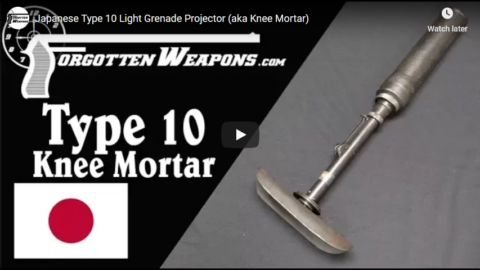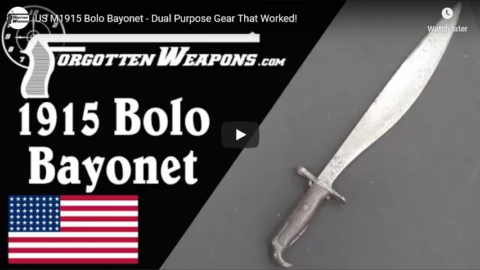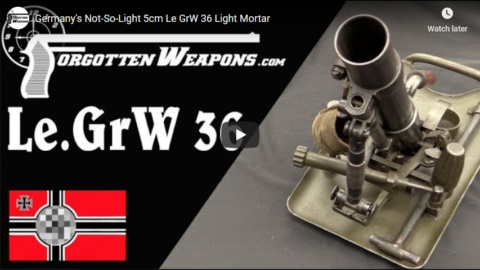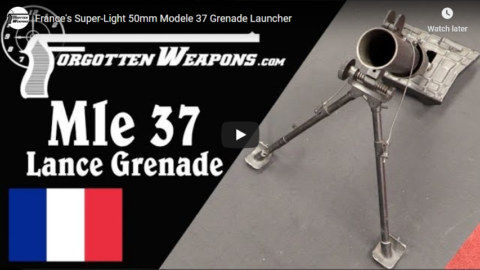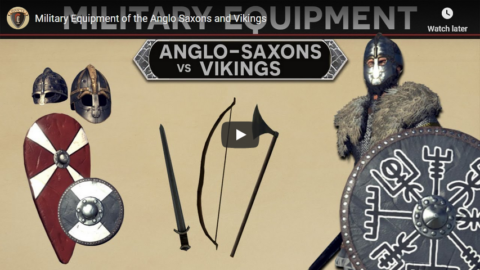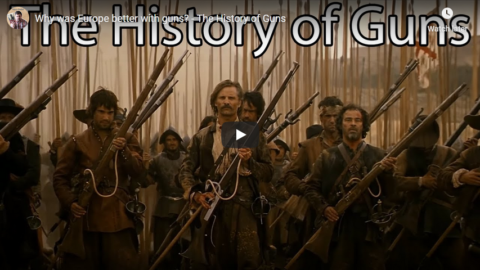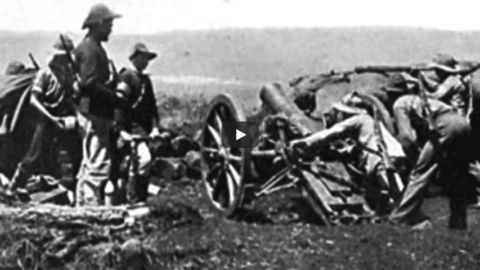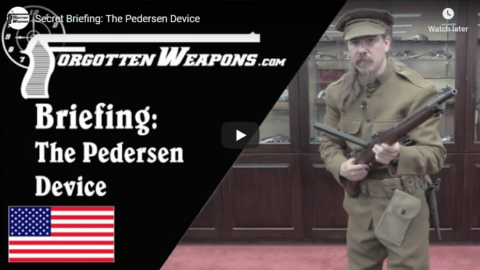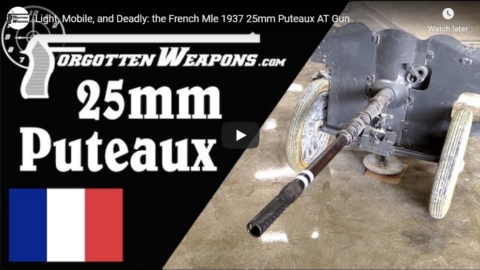Forgotten Weapons
Published 30 Aug 2017When World War One began, the British did not have a formal sniping program, and by 1915 the British found themselves thoroughly outclassed by the Germans in this area. They responded by developing tactics and equipment for sniping, and by mid 1916 they had really outclassed the Germans. However, the mid-war British sniping rifles really left a lot to be desired, even if they were being used effectively in the field. There was no single military optic, instead a wide variety of commercial scopes were rounded up and put into use. The mounts for these scopes were offset to the left side of the rifles to allow for continued use of stripper clips. Clips were arguably not really necessary on these rifles, and the offset scopes led to substantial headaches in use, as they required calculating windage as well as elevation adjustments depending on range.
Through 1918, though, the British developed one of the best sniping rifles of the war, although it would be introduced too late to see virtually any front line service. This new rifle was a Winchester-made Pattern 1914 Enfield with a center-mounted optic, and was designated the P14 MkI W(T). The P14 rifles were more accurate than the SMLE, and the centrally mounted optic made for much simpler shooting. These rifles were deemed to be mechanically capable of 1.5 MOA shooting, with the practical expected group size being 3 MOA.
Three thousand of these P14 snipers’ rifles were assembled and kept in service after the end of the war, but in the mid 1930s a small additional batch of 79 were made for the Irish Free State by BSA. These were all eventually surplussed to the US, and the rifle in this video is one of those late-production guns.
http://www.patreon.com/ForgottenWeapons
Cool Forgotten Weapons merch! http://shop.bbtv.com/collections/forg…
If you enjoy Forgotten Weapons, check out its sister channel, InRangeTV! http://www.youtube.com/InRangeTVShow
December 1, 2020
Pattern 14 MKI W (T) – The Best Sniper Rifle of World War One
November 19, 2020
Japanese Type 10 Light Grenade Projector (aka Knee Mortar)
Forgotten Weapons
Published 24 Mar 2018In the aftermath of World War One, the Japanese military saw the utility of infantry-portable light grenade launchers instead of rifle grenades, and adopted the Type 10 in 1921 (Taisho 10). It went into production in 1923 at the Tokyo Army Arsenal, although the great Tokyo earthquake led to production being moved to Nagoya, where about 11,000 were made between 1925 and 1937. The Type 10 was a remarkably light and handy weapon, weighing just 5.5lb (2.5kg) and disassembling into a transport configuration the size of a wine bottle.
The larger Type 89 grenade launcher was adopted in 1929, which led to the older Type 10s being relegated to use for illumination and signaling, which they did through the end of World War Two.
http://www.patreon.com/ForgottenWeapons
Cool Forgotten Weapons merch! http://shop.bbtv.com/collections/forg…
If you enjoy Forgotten Weapons, check out its sister channel, InRangeTV! http://www.youtube.com/InRangeTVShow
Contact:
Forgotten Weapons
6281 N Oracle #36270
Tucson, AZ 85704
I posted Ian’s review of the Type 89 here.
November 16, 2020
US M1915 Bolo Bayonet – Dual Purpose Gear That Worked!
Forgotten Weapons
Published 27 Nov 2017The M1915 bolo bayonet was originally the brainchild of US Army Captain Hugh D. Wise, Quartermaster with the 9th Infantry in the Philippines. In 1902, he recommended the implement in a letter to his superior officers, noting that a bolo style of bayonet (ie, one with a widened machete-like blade) would have several advantages over the standard knife bayonet then being issued with the Krag-Jorgenson rifles the US Army was using. Specifically, the wider bayonet would be easier to recover after a thrust (he noted several instances of troopers being killed while trying to extricate their bayonets from enemies) and also (and more significantly) make an excellent and necessary bushwhacking tool in the jungle environment of the Philippines.
Wise’s idea was taken with interest and Springfield produced a series of experimental bolo bayonets, but the project ended there as the 1903 Springfield was adopted with a rod bayonet instead of a blade. Of course, the rod bayonet would be shortlived, and the blade bayonet would come back. The bolo bayonet ideas resurfaced in 1911 when a commission was formed to look into special equipment for the Philippine Scouts. After another series of experimental designs, the M1915 Bolo bayonet was formally adopted on May 22, 1915 and an order was placed for 6,000 of them to be made at Springfield Armory.
Delivery of these bayonets took place in 1915 and 1916, and they proved to be extremely popular tools with the soldiers in the Philippines. They would remain in service on the islands until World War Two, serving at last as a replacement for the M1913 cavalry saber for the 26th Cavalry.
http://www.patreon.com/ForgottenWeapons
Cool Forgotten Weapons merch! http://shop.bbtv.com/collections/forg…
If you enjoy Forgotten Weapons, check out its sister channel, InRangeTV! http://www.youtube.com/InRangeTVShow
November 15, 2020
QotD: Early successes in recruit training
Still, we are getting on. Number Three Platoon (which boasts a subaltern) has just marched right round the barrack square, without —
(1) Marching though another platoon.
(2) Losing any part or parts of itself.
(3) Adopting a formation which brings it face to face with a blank wall, or piles it up in a tidal wave upon the verandah of the married quarters.
They could not have done that a week ago.
Ian Hay (Major John Hay Beith), The First Hundred Thousand: Being the Unofficial Chronicle of a Unit of “K(1)”, 1916.
October 30, 2020
QotD: Artillery “duels”
Each afternoon we creep unostentatiously into subterranean burrows, while our respective gunners, from a safe position in the rear, indulge in what they humorously describe as “an artillery duel.” The humour arises from the fact that they fire, not at one another, but at us.
Ian Hay (Major John Hay Beith), The First Hundred Thousand: Being the Unofficial Chronicle of a Unit of “K(1)”, 1916.
October 3, 2020
[Weapons 101] How does a Mortar work?
Military History Visualized
Published 25 Mar 2016Patreon: https://www.patreon.com/join/mhv
Modern mortars evolved from the so-called “Stokes Mortar”, but the basic principles still apply. This video gives you a short overview on mortars.
A modern mortar is a weapon that provides short-range indirect fire at high angles, usually between 45 and 80 degree. Unlike traditional (old) mortars it was relatively small and mobile, which made it well-suited for trench warfare and also maneuver warfare, because unlike unwieldy artillery it could be used directly by the infantry units at the front line.
Script and further information here: http://militaryhistoryvisualized.com/…
—Social Media—
twitter: https://twitter.com/MilHiVisualized
tumblr: http://militaryhistoryvisualized.tumb…—Sources—
–Books–
Hogg, Ian V.: The Illustrated Encyclopedia of Ammunition–Websites & Links–
Great video that shows the removal of several augmenting charges at around 3:00
https://www.youtube.com/watch?v=hpy9O…http://www.globalsecurity.org/militar…
—Notes on Accuracy & “Methodology”—
Note that the mortar shell and mortar are not of the same type (and diameter in real life), but the functionality is similar.
1) The depicted Mortar Shell is a 8cm Wgr 38.
2) The depicted detailed Mortar is roughly a Esperanza 60mm Model “L” Mortar.
3) The depicted Mortars in the beginning are US M2 60mm mortars.
September 24, 2020
PIAT: Britain’s Answer to the Anti-Tank Rifle Problem
Forgotten Weapons
Published 25 Nov 2017Sold for $3,163.
The British began World War Two with the Boys antitank rifle, but like all antitank rifles it rather quickly became obsolete. The replacement for it was adopted in 1942 as the PIAT – Projector, Infantry, Anti-Tank. This was a unique sort of weapon which fired a 3 pound (~1.35kg) hollow charge projectile using a combination of a massive spring and a firing charge much like a rifle grenade blank cartridge — a spigot mortar, really. The large (3.25″, 83mm) projectile was able to defeat almost any tank that would be developed during the war, as it could burn through 3-4 inches of hardened armor. However, it had a terrifyingly short effective range — 110 yards on paper and more like 50 yards in practice.
The PIAT would recock itself upon firing, but the initial cocking was something like a crossbow, requiring the shooter to brace their feet on the buttplate and pull the body of the weapon upwards, compressing the 200 pound (90kg) mainspring. When fired, the weapon has a pretty harsh recoil, although it did not have any flash or backblast like the American Bazooka did. By the end of the war more 115,000 PIATs had been made, and they would serve the British military into the 1950s, when they were replaced with more traditional rocket launchers.
http://www.patreon.com/ForgottenWeapons
Cool Forgotten Weapons merch! http://shop.bbtv.com/collections/forg…
If you enjoy Forgotten Weapons, check out its sister channel, InRangeTV! http://www.youtube.com/InRangeTVShow
QotD: Gurkha versus Japanese, mano a mano
Favourite of [Field Marshal Viscount] Slim’s tales of these wonderful little fighters from the Himalayas is that of the Gurkha who met a Japanese in No Man’s Land. Jap and Gurkha decided to have it out in a duel, each using his own chosen steel. The Jap swiped at his opponent with his two handed sword, which the Gurkha avoided. Then, the Gurkha slashed with his kukri, the broad, curved knife which is his traditional weapon. “So, you missed, eh?” jeered the Jap. “You just sneeze,” said the Gurkha, “and see what happens to your head.”
September 18, 2020
Germany’s Not-So-Light 5cm LeGrW 36 Light Mortar
Forgotten Weapons
Published 2 Sep 2018Sold for $18,400
http://www.patreon.com/ForgottenWeapons
Cool Forgotten Weapons merch! http://shop.bbtv.com/collections/forg…
The 5cm 5CM Leichter Granatwerfer 36 was the standard German light infantry mortar going into World War Two. It was designed by Rheinmetall-Borsig in the mid 1930s and adopted in 1936. It fired a 0.9kg / 2 pound mortar bomb with a range of up to 550 meters. In theory, it occupied the same role as the French Mle 1937 50mm light mortar — except it was far heavier than was practical, and substantially more complex to use. The LeGrW 36 weighed in at a hefty 31 pounds (14kg) – nearly four times as much as its French counterpart.
It was a striker fired design, with a trigger lever and thus did not fire immediately upon a round being loaded. It used adjustments in angle to determine range, with a constant projectile velocity (as opposed to venting a varying amount of propellent gas to adjust range). By the middle of the war, it was being pulled out of front-line use, as its weight and relative complexity made it impractical for its intended role.
If you enjoy Forgotten Weapons, check out its sister channel, InRangeTV! http://www.youtube.com/InRangeTVShow
September 15, 2020
France’s Super-Light 50mm Modele 37 Grenade Launcher
Forgotten Weapons
Published 1 Sep 2018Sold for $1,725
http://www.patreon.com/ForgottenWeapons
Cool Forgotten Weapons merch! http://shop.bbtv.com/collections/forg…
A new very light and portable mortar to replace the V-B rifle grenade was one of the facets of the French plan for rearmament and modernization after World War I. The concept for the weapons that would become the L.Gr. Mle 37 was first requested in 1924 — but like so almost all the other parts of that arms program, it was crippled by delays through the 1920s and 1930s. Only in the late 1930s when war was looking imminent did the program finally move forward.
The design, created by Captain Nahan of the Chatellerault arsenal, was adopted in 1937 and a whopping 21,950 were ordered in January of 1938 — and the order was quickly revised up to 50,000. However, only 2900 had been produced by the time of the armistice in June 1940. Production resumed in 1944, and the launcher did see use in Indochina. In addition, its 50mm grenade was the basis for the postwar French rifle grenades, as used on the MAS-36 LG 48, the MAS-44, and MAS-49 rifles. As fired from the mortar, the projectile weighed about one pound (0.4kg) and had a range of 80 to 460 meters, with an effective rate of fire up to 20 rounds per minute.
If you enjoy Forgotten Weapons, check out its sister channel, InRangeTV! http://www.youtube.com/InRangeTVShow
August 31, 2020
Military Equipment of the Anglo Saxons and Vikings
Invicta
Published 19 Apr 2018Today we dive into the world of Early Medieval England to analyze the military equipment available to the warring Anglo Saxons and Vikings!
Support future documentaries: https://www.patreon.com/InvictaHistory
Twitter: https://twitter.com/InvictaHistoryDocumentary Credits:
Research: Invicta
Script: Invicta
Artwork: Osprey Publishing
Game: Total War Saga: Thrones of Britannia
Editing: Invicta
Music: Total War: Attila and Total War Battles: Kingdoms SoundtrackLiterary Sources
–Anglo-Saxon Thegn by Mark Harrison (Osprey Publishing)
–Viking Hersir 793–1066 AD by Mark Harrison (Osprey Publishing)
–Saxon, Viking and Norman by Terence Wise (Osprey Publishing)
Why was Europe better with guns? – The History of Guns
History Clarified
Published 3 Dec 2018China invented gunpowder (combustible powder), so why was it the European nations that went out and conquered the world using firearms?
This video looks at some geographical factors to examine what allowed Europe to innovate while China and most of the world fell behind with gunpowder weapons.
This focuses heavily on Kenneth Chase’s Book, Firearms: A Global History to 1700. He tries to get away from just looking at drill, organization, and state production of firearms to see how geography helped create the necessary conditions for those other innovations.
Interested in your own copy? Check out the link below:
DISCLAIMER: This video description contains affiliate links, which means that if you click on one of the product links below, I’ll receive a small commission.
The map of Japan is under Creative Commons 4.0.
August 24, 2020
Why the British Army was so effective in 1914 – Learning lessons from the Boer War
History West Midlands
Published 10 Oct 2014When Britain despatched an Expeditionary Force (the BEF) to the Continent in August 1914, the German Kaiser issued an order of the day to his generals to “walk over General French’s contemptible little army”.
But despite being heavily outnumbered, this small force, including many men from the West Midlands, played a vital role in stopping the seemingly overwhelming German advance across Belgium and into France.
Small in size compared with the much larger armies of France and Germany, the BEF was highly effective. This was in stark contrast to the disasters that the British Army had experienced a few years earlier at the start of the Second Boer War (1899-1902) in South Africa.
August 1, 2020
Secret Briefing: The Pedersen Device
Forgotten Weapons
Published 8 Aug 2016http://www.patreon.com/ForgottenWeapons
Welcome to your briefing on the new equipment we are issuing for the Spring Offensive of 1919. With this new secret weapon, we can finally push the Germans out of France and end the war!
July 5, 2020
Light, Mobile, and Deadly: the French Mle 1937 25mm Puteaux AT Gun
Forgotten Weapons
Published 20 Mar 2020http://www.patreon.com/ForgottenWeapons
https://www.floatplane.com/channel/Fo…
Cool Forgotten Weapons merch! http://shop.bbtv.com/collections/forg…
After World War One, the French military set up a program to modernize all of its weaponry, and that included a replacement for the Mle 1916 light infantry cannon. An anti-tank gun had not been necessary during the Great War, as Germany never fielded tanks in substantial numbers — but as a pioneer of the modern tank, the French recognized the need for a good AT gun. Taking a lesson from World War One, they wanted a light gun that was flexible and mobile, easily moved around the battlefield and easily concealed from enemy fire. A 25mm cartridge was specified, and both the Hotchkiss company and the Puteaux arsenal created guns to use it. Both were adopted into service, with the Hotchkiss Mle 1934 being a bit heavier and the Puteaux Mle 1937 being a bit lighter, at only about 600 pounds. The Puteaux gun was quite small, easily moved by a horse or virtually any motorized vehicle. It had a long barrel and the 25mm AP projectile had a muzzle velocity of about 3150 fps, making it quite effective on the light and medium tanks of the 1930s. It was also remarkably accurate, and the long barrel and flash hider gave it a very small firing signature. Aiming was done with either a 4x magnified optic or a set of backup iron sights.
A total of 1285 of these guns were made before the armistice of June 1940, and they served ably in the Battle of France. A few were also used by the British before Dunkirk, and after the armistice they were used by German forces in limited numbers, and also supplied to Spain and Finland as military aid (this particular one has a Finnish property tag on it).
Thanks to DriveTanks.com in Uvalde Texas for giving me access to film this Puteaux cannon for you!
Contact:
Forgotten Weapons
6281 N. Oracle #36270
Tucson, AZ 85740


